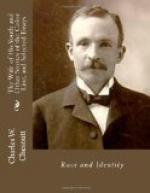“Dinah!” she said in a peevish tone; “Dinah!”
Receiving no answer, Mrs. Myrover peered around the kitchen, and caught sight of Sophy.
“What are you doing here?” she demanded.
“I-I ‘m-m waitin’ ter see de cook, ma’am,” stammered Sophy.
“The cook is n’t here now. I don’t know where she is. Besides, my daughter is to be buried to-day, and I won’t have any one visiting the servants until the funeral is over. Come back some other day, or see the cook at her own home in the evening.”
She stood waiting for the child to go, and under the keen glance of her eyes Sophy, feeling as though she had been caught in some disgraceful act, hurried down the walk and out of the gate, with her bouquet in her hand.
“Dinah,” said Mrs. Myrover, when the cook came back, “I don’t want any strange people admitted here to-day. The house will be full of our friends, and we have no room for others.”
“Yas ’m,” said the cook. She understood perfectly what her mistress meant; and what the cook thought about her mistress was a matter of no consequence.
The funeral services were held at St. Paul’s Episcopal Church, where the Myrovers had always worshiped. Quite a number of Miss Myrover’s pupils went to the church to attend the services. The building was not a large one. There was a small gallery at the rear, to which colored people were admitted, if they chose to come, at ordinary services; and those who wished to be present at the funeral supposed that the usual custom would prevail. They were therefore surprised, when they went to the side entrance, by which colored people gained access to the gallery stairs, to be met by an usher who barred their passage.
“I ’m sorry,” he said, “but I have had orders to admit no one until the friends of the family have all been seated. If you wish to wait until the white people have all gone in, and there ’s any room left, you may be able to get into the back part of the gallery. Of course I can’t tell yet whether there ’ll be any room or not.”
Now the statement of the usher was a very reasonable one; but, strange to say, none of the colored people chose to remain except Sophy. She still hoped to use her floral offering for its destined end, in some way, though she did not know just how. She waited in the yard until the church was filled with white people, and a number who could not gain admittance were standing about the doors. Then she went round to the side of the church, and, depositing her bouquet carefully on an old mossy gravestone, climbed up on the projecting sill of a window near the chancel. The window was of stained glass, of somewhat ancient make. The church was old, had indeed been built in colonial times, and the stained glass had been brought from England. The design of the window showed Jesus blessing little children. Time had dealt gently with the window, but just at the feet of the figure of Jesus a small triangular piece of glass had been broken out. To this aperture Sophy applied her eyes, and through it saw and heard what she could of the services within.




